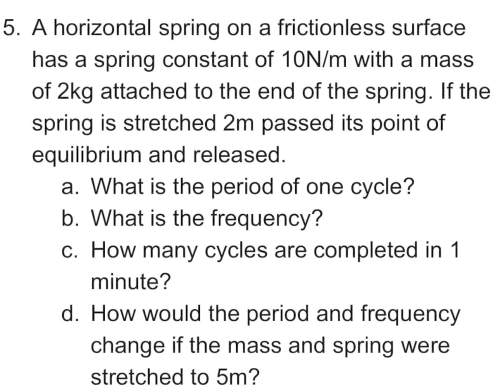
B. the length of the spring. If a force of 3N is hung on it; assuming Hooke's law is obeye
TAKE HOME ASSIGNMENT
State Hooke's law of elasticity,
Sketch the graph of stress/extension against strain/load and locate the:
a. Proportionality limit
b. Elastic limit
c. Yield point
d. Breaking point
e. Elastic region
f. Plastic region. (Use A4 paper or Cardboard sheet)
3.
A spiral spring has a length of 14cm when a force of 4N is hung on it. A force of ON
extends the spring by 4cm. Calculate the:
a. unstretched length of the spring;
A

Answers: 3
Another question on Physics

Physics, 21.06.2019 22:50
Two horizontal plates with infinite length and width are separated by a distance h in the z direction. the bottom plate is moving at a velocity u. the incompressible fluid trapped between the plates is moving in the positive x-direction with the bottom plate. align gravity with positive z. assume that the flow is fully-developed and laminar. if the systems operates at steady state and the pressure gradient in x-direction can be ignored, do the following: 1. sketch your system 2. identify the coordinate system to be used. 3. show your coordinates and origin point on the sketch. list all your assumptions. 5. apply the continuity equation to your system. nts of navier stokes equations of choice to your system 7. solve the resulting differential equation to obtain the velocity profile within the system make sure to list your boundary conditions. check units of velocity 8. describe the velocity profile you obtain using engineering terminology. sketch that on the same sketch you provided in (1). 9. obtain the equation that describes the volumetric flow rate in the system. check the units.
Answers: 2

Physics, 21.06.2019 23:20
According to newton's second law, when the same force is applied to two objects of different masses, a the object with greater mass will experience a great acceleration, and the object with less mass will experience an even greater acceleration, b. the object with greater mass will experience a smaller acceleration, and the object with less mass will experience a greater acceleration, c. the object with greater mass will experience a greater acceleration, and the object with less mass will experience a smaller acceleration, d. the object with greater mass will experience a small acceleration, and the object with less mass will experience an even smaller acceleration.
Answers: 1

Physics, 22.06.2019 12:30
When a vertical beam of light passes through a transparent medium, the rate at which its intensity i decreases is proportional to i(t), where t represents the thickness of the medium (in feet). in clear seawater, the intensity 3 feet below the surface is 25% of the initial intensity i0 of the incident beam. what is the intensity of the beam "10" feet below the surface? (give your answer in terms of i0. round any constants or coefficients to five decimal places.)
Answers: 2

Physics, 22.06.2019 13:00
Ways that industry and agriculture use physical properties to separate substances
Answers: 1
You know the right answer?
B. the length of the spring. If a force of 3N is hung on it; assuming Hooke's law is obeye
TAKE HOM...
Questions

Mathematics, 10.10.2019 16:30

History, 10.10.2019 16:30

Biology, 10.10.2019 16:30

Social Studies, 10.10.2019 16:30




Mathematics, 10.10.2019 16:30

Mathematics, 10.10.2019 16:30


Mathematics, 10.10.2019 16:30



Biology, 10.10.2019 16:30

Health, 10.10.2019 16:30

History, 10.10.2019 16:30

Mathematics, 10.10.2019 16:30



Social Studies, 10.10.2019 16:30




